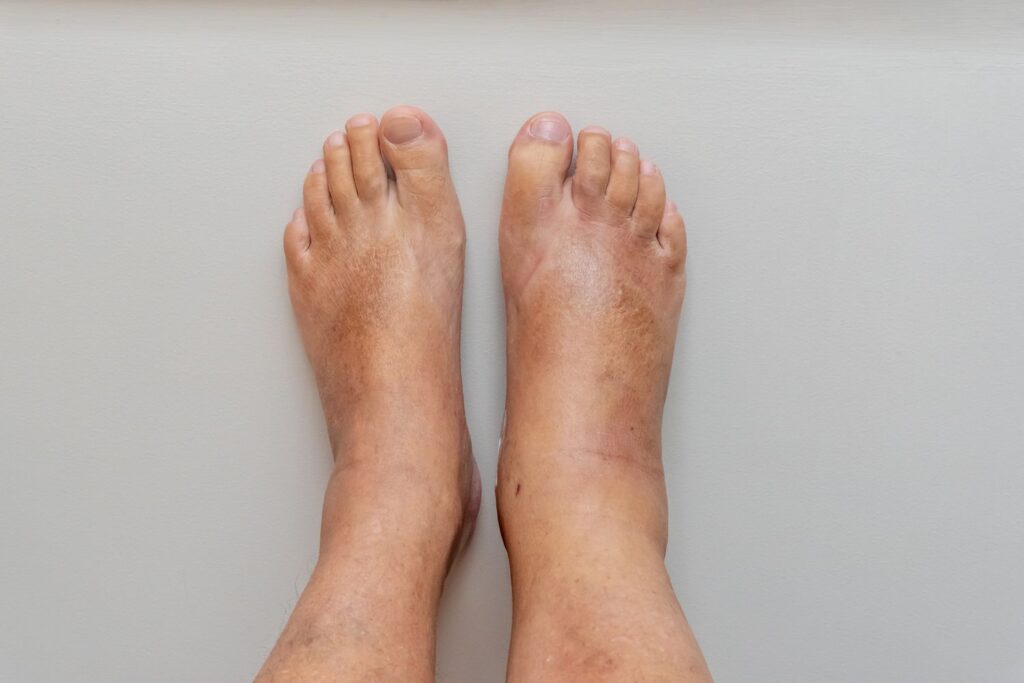Are swollen feet or ankles putting a damper on your day? Don’t fret, because we’ve got you covered with some top tips on how to prevent this uncomfortable condition. Whether it’s due to long hours on your feet or certain health conditions, swollen extremities can be a real nuisance. But fear not, because with a few simple lifestyle adjustments and self-care practices, you can keep those feet and ankles feeling happy and healthy. So, kick back, put your feet up (but not for too long), and let’s dive into the world of preventing swollen feet or ankles!

Wear Proper Footwear
When it comes to preventing swollen feet or ankles, one of the first steps you can take is to wear proper footwear. Choosing shoes with a comfortable fit is essential. Ill-fitting shoes can constrict your feet and cause swelling, so opt for shoes that allow for adequate wiggle room. Avoid high-heeled or tight shoes that can put pressure on your feet and ankles. Instead, opt for shoes with good arch support to help distribute your weight evenly. Consider wearing compression socks or stockings as well. These can help improve circulation and reduce swelling in your lower limbs.
Maintain a Healthy Weight
Maintaining a healthy weight plays a crucial role in preventing swollen feet or ankles. Excess weight puts additional pressure on your feet, which can lead to swelling. To maintain a healthy weight, follow a balanced diet that includes plenty of fruits, vegetables, lean proteins, and whole grains. Engage in regular physical activity to burn calories and maintain muscle tone. Avoid excessive salt intake, as a high-sodium diet can contribute to fluid retention and swelling. Stay hydrated by drinking plenty of water throughout the day to help flush out toxins and reduce swelling.

Exercise Regularly
Regular exercise is not only beneficial for overall health but also helps prevent swollen feet or ankles. Engaging in activities that strengthen leg and foot muscles can help improve circulation and reduce fluid buildup. Simple exercises like calf raises, toe curls, and ankle flexion and rotation exercises can strengthen the muscles in your lower limbs. If you have a sedentary job that requires long periods of sitting or standing, make sure to take breaks to move around. Walking or swimming are excellent low-impact activities that can improve circulation and reduce the risk of swelling.
Elevate Your Feet
Elevating your feet can provide relief and help prevent swelling. When sitting, put your feet up on a footrest or ottoman to elevate them above heart level. This position promotes better blood flow and reduces the risk of fluid accumulation in your lower limbs. Avoid crossing your legs for extended periods, as this can restrict circulation and contribute to swelling. If you experience swelling during sleep, prop up your feet with pillows to elevate them while you rest. This simple practice can help reduce fluid buildup in your feet and ankles.

Avoid Prolonged Sitting or Standing
Prolonged sitting or standing can contribute to swollen feet or ankles. To prevent this, make sure to take frequent breaks to move around and avoid maintaining the same position for too long. Changing positions regularly can help improve circulation and reduce the risk of fluid accumulation. If you have a desk job that requires long hours of sitting, consider using a standing desk or elevate one foot periodically while standing. This helps relieve pressure on your feet and ankles and promotes better blood flow. It is crucial to avoid sitting or standing for extended periods without movement, as this can lead to swelling.
Practice Leg and Foot Massage
Giving your legs and feet regular massages can help prevent swelling. Massaging your legs and feet not only improves circulation but also promotes relaxation and reduces discomfort. Use gentle pressure when massaging to avoid causing any pain or damage. You can enhance the massage experience by utilizing essential oils or moisturizers, which can help nourish your skin and provide additional relaxation benefits. If you prefer a more professional approach, consider seeking out a licensed massage therapist who specializes in foot and leg massages. They can provide targeted relief and assist in preventing swelling.

Apply Cold Compress or Soak in Cold Water
Cold therapy can be effective in reducing swelling in your feet or ankles. To apply a cold compress, use ice packs or frozen vegetables wrapped in a towel and place them on the swollen areas. The cold temperature constricts blood vessels and reduces inflammation. Another option is to soak your feet or ankles in cold water for 15-20 minutes. The cold water helps soothe inflammation and offers temporary relief from swelling. Repeat this process several times a day to help manage and prevent swelling in your lower extremities.
Avoid Excessive Heat
Excessive heat can worsen swelling in your feet or ankles, so it’s important to take precautions. Avoid hot baths or showers, as the heat can dilate blood vessels and cause fluid retention. Instead, opt for lukewarm water to prevent exacerbating the swelling. Keep the room temperature cool to reduce the risk of heat-related swelling. If you spend time outdoors, avoid exposing your feet or ankles to direct sunlight for prolonged periods. Direct sun exposure can lead to increased inflammation and swelling. Additionally, avoid hot tubs or saunas, as they can also contribute to fluid retention and worsen swelling.
Manage Underlying Health Conditions
Certain underlying health conditions can contribute to swollen feet or ankles. It is crucial to manage these conditions effectively to prevent or reduce swelling. Control your blood pressure and cholesterol levels through medication, lifestyle modifications, and regular monitoring. Properly manage diabetes by following your healthcare professional’s advice regarding medication, diet, and exercise. Seek treatment for any heart, liver, or kidney diseases that may be contributing to swelling. It is important to consult with a healthcare professional who can provide guidance and develop a comprehensive treatment plan to manage these conditions effectively.
Seek Medical Evaluation
If swelling in your feet or ankles persists or worsens, it is essential to seek medical advice. A healthcare professional can provide appropriate diagnosis and treatment options based on the underlying cause of your swelling. It is important to consult with a healthcare professional when experiencing persistent or severe swelling to rule out any serious underlying conditions. Discuss any concerns or additional symptoms you may have to ensure a comprehensive evaluation. Follow the recommended treatment plans provided by your healthcare professional to effectively manage and prevent swelling in your lower limbs.
